JKL Temperature Analysis#
Exploring Digital Elevation Model (DEM) and ERA5 Climate Data#
Region Focus: Jammu, Kashmir, and Ladakh (JKL)#
Custom defining plotting parameters#
plt.rcParams['axes.labelsize']= 14
plt.rcParams['xtick.labelsize']= 14
plt.rcParams['ytick.labelsize']= 14
plt.rcParams['legend.fontsize']= 14
plt.rcParams['font.size']=14
plt.rcParams['xtick.direction']='in'
plt.rcParams['xtick.major.size']= 5
plt.rcParams['xtick.major.width']= 1
plt.rcParams['xtick.minor.size']= 1.5
plt.rcParams['xtick.minor.width']= 1
plt.rcParams['ytick.direction']='in'
plt.rcParams['ytick.major.size']= 5
plt.rcParams['ytick.major.width']= 1
plt.rcParams['ytick.minor.size']= 1.5
plt.rcParams['ytick.minor.width']= 1
plt.rcParams['axes.linewidth']= 0.8
plt.rcParams['grid.linewidth']= 0.8
plt.rcParams['font.style'] = "normal"
plt.rcParams['font.weight'] = "bold"
Important functions#
Below given functions are needed to download the SRTM data, here we are only defining these, but will apply as we move ahead
def init_header_redirect_session(token=None):
token = os.environ.get("EARTHDATA_BEARER_TOKEN", token)
if token is None:
raise ValueError("EARTHDATA_BEARER_TOKEN environment variable missing.")
session = requests.Session()
session.headers.update({"Authorization": f"Bearer {token}"})
return session
def download_srtm(filename, destination, resolution=3, session=None):
website = "https://e4ftl01.cr.usgs.gov/MEASURES"
subres = '2' if resolution == 30 else '3'
resolution = f"SRTMGL{resolution}.00{subres}"
source = f"{website}/{resolution}/2000.02.11"
url = f"{source}/{filename}"
session = session or init_header_redirect_session()
with session.get(url, stream=True, timeout=5) as r:
r.raise_for_status()
with open(destination or filename, "wb") as fd:
for chunk in r.iter_content(chunk_size=1024*1014):
fd.write(chunk)
return r.status_code
def get_srtm_tile_names(extent):
lonmin, lonmax, latmin, latmax = [int(np.floor(x)) for x in extent]
return [f"{'N' if lat >= 0 else 'S'}{abs(lat):02d}{'E' if lon >= 0 else 'W'}{abs(lon):03d}"
for lat in range(latmin, latmax + 1) for lon in range(lonmin, lonmax + 1)]
def get_srtm(extent, resolution=3, merge=True, session=None, filename=""):
filelist = [f"{f}.SRTMGL{resolution}.hgt.zip" for f in get_srtm_tile_names(extent)]
dem_path = os.path.join("demler_data", "geo")
os.makedirs(dem_path, exist_ok=True)
demlist = []
session = session or init_header_redirect_session()
for filename in filelist:
path = os.path.join(dem_path, filename)
if not os.path.exists(path):
download_srtm(filename, path, resolution=resolution, session=session)
if os.path.exists(path):
demlist.append(gdal.Open(path))
if not merge:
return demlist
output_filename = 'merged_dem.tif'
dem = gdal.Warp(output_filename, demlist, format="GTiff")
xds = rio.open_rasterio(output_filename)
# Since it is very high resolution data, we can coarsen it to match
# a little bit for now to save some space
xds = xds.coarsen(x=12, y=12, boundary='trim').mean()
xds.rio.to_raster(output_filename)
return xds
Download DEM#
Setting environment for downloading DEM data, you have to generate a token (only once) in order to download the SRTM data at this website https://urs.earthdata.nasa.gov/
Setup environment#
from earth_data_token import token
Remember to create your account and paste the token here.
Get token from https://urs.earthdata.nasa.gov/
os.environ["EARTHDATA_BEARER_TOKEN"] = token
# os.environ["EARTHDATA_BEARER_TOKEN"] = 'paste token here and uncomment this line and run it'
Download SRTM#
We are using
get_srtmfunction that takes the argumentextentas a list, you have to provide 4 points, i.e., lonmin, lonmax, latmin, and latmax.It will save the file as a tif format, we will use xarray based python package called rioxarray to read the data
# Define the extent [lonmin, lonmax, latmin, latmax]
extent = [72, 80, 30, 37] # Example extent
# Call get_srtm with the extent, resolution, and merge option
# Example uses a resolution of 3 and merges tiles
dataset = get_srtm(extent, resolution=3, merge=True)
/Users/syed44/miniconda3/envs/radar/lib/python3.12/site-packages/osgeo/gdal.py:312: FutureWarning: Neither gdal.UseExceptions() nor gdal.DontUseExceptions() has been explicitly called. In GDAL 4.0, exceptions will be enabled by default.
warnings.warn(
Now that we have downloaded the file, we can read that using rioxarray
xds = rio.open_rasterio('merged_dem.tif')
# Since it is very high resolution data, we can coarsen it to match
# it with the ERA5 0.1 x 0.1 resolution data.
# xds_cs = xds.coarsen(x=12, y=12, boundary='trim').mean()
Download JK shape files#
Uncomment the below cell, and run it only once to download the shape files
# !git clone https://github.com/syedhamidali/India-Shapefiles.git
Read shape files#
# Load GeoDataFrame
gdf = gpd.read_file('India-Shapefiles/India States Boundary/')
# Specify states to combine
states_to_combine = ['Ladakh', 'Jammu and Kashmir']
# Filter for the states to combine
jkl = gdf[gdf['Name'].isin(states_to_combine)]
# Combine the geometries into a single geometry
combined_geometry = jkl.geometry.unary_union
# Create a new GeoDataFrame for the combined geometry
combined_jkl = gpd.GeoDataFrame([{'Name': 'JKL', 'geometry': combined_geometry}],
crs=jkl.crs) # Ensure the CRS is consistent
combined_jkl.plot(ec='k', fc='none')
<Axes: >
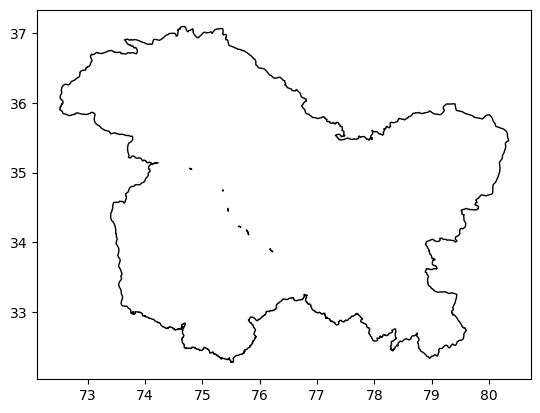
Clip DEM with the Shape file#
We will mask all the raster data or DEM data using outside the JK boundary using these shape files. This is important for bringing all datsets to the same level
xds.rio.write_crs(combined_jkl.crs, inplace=True)
# Clip xds_cs using the combined_jkl boundary
xds_clipped = xds.rio.clip(combined_jkl.geometry, combined_jkl.crs, drop=True, invert=False)
xds_above_zero = xds_clipped[0].where(xds_clipped[0]>0)
xds_cs = xds_above_zero.coarsen(x=10, y=10, boundary='trim').mean()
xds_cs
<xarray.DataArray (y: 48, x: 78)> Size: 30kB
array([[nan, nan, nan, ..., nan, nan, nan],
[nan, nan, nan, ..., nan, nan, nan],
[nan, nan, nan, ..., nan, nan, nan],
...,
[nan, nan, nan, ..., nan, nan, nan],
[nan, nan, nan, ..., nan, nan, nan],
[nan, nan, nan, ..., nan, nan, nan]])
Coordinates:
band int64 8B 1
* x (x) float64 624B 72.56 72.66 72.76 72.86 ... 80.06 80.16 80.26
* y (y) float64 384B 37.05 36.95 36.85 36.75 ... 32.55 32.45 32.35
spatial_ref int64 8B 0
Attributes:
AREA_OR_POINT: Point
units: m
scale_factor: 1.0
add_offset: 0.0
_FillValue: -32768.0Plot DEM#
Let’s see what we have got so far
fig = plt.figure(figsize=[16, 7], constrained_layout=True)
ax = plt.subplot(121, projection=ccrs.PlateCarree())
img = xds_above_zero.plot.imshow(cmap='turbo', vmin=0, vmax=5000, ax=ax, add_colorbar=False)
mf.map_features(ax, b=True, l=True, states=False)
ax.set_title("True Elevation")
combined_jkl.plot(ax=ax, ec='k', fc='none')
ax.set_aspect('equal')
ax = plt.subplot(122, projection=ccrs.PlateCarree())
xds_above_zero.where(xds_above_zero>3000).plot.imshow(cmap='turbo',
vmin=0, vmax=5000, ax=ax, add_colorbar=False)
combined_jkl.plot(ax=ax, ec='k', fc='none')
mf.map_features(ax, b=1, l=0, states=False,)
ax.set_title("> 3000 m")
ax.set_aspect('equal')
cbar_ax = fig.add_axes([1, 0.25, 0.02, 0.5],) #lbwh
cbar1 = fig.colorbar(img, cax=cbar_ax,orientation='vertical')
cbar1.set_label('Elevation [m]')

xds_cs.plot(cmap='terrain') # remember this xds_cs dataset, we'll use it for the main analysis
<matplotlib.collections.QuadMesh at 0x2999e1c40>
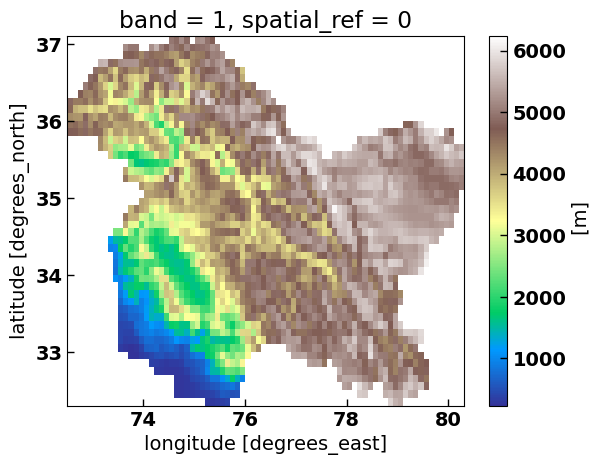
Download ERA5 data#
I’ll use the python API to download the reanalysis-era5-land-monthly-means data, but you are welcome to use whatever data you like, and however you wish to download that.
Uncomment the below code to download the temperature data from ERA5
# import cdsapi
# c = cdsapi.Client()
# c.retrieve(
# 'reanalysis-era5-land-monthly-means',
# {
# 'product_type': 'monthly_averaged_reanalysis',
# 'variable': '2m_temperature',
# 'year': '2023',
# 'month': [
# '01', '02', '03',
# '04', '05', '06',
# '07', '08', '09',
# '10', '11', '12',
# ],
# 'time': '00:00',
# 'area': [
# 45, 70, 30,
# 85,
# ],
# 'format': 'grib',
# },
# 'ERA_JK.grib')
Read ERA5 Data#
I’ll use temperature data in this study. We have to make the data identical to xds_cs.
ds = xr.open_dataset('ERA_JK.grib', engine='cfgrib')
ds.rio.write_crs(combined_jkl.crs, inplace=True)
# Clip xds_cs using the combined_jkl boundary
ds_clipped = ds.rio.clip(combined_jkl.geometry, combined_jkl.crs, drop=True, invert=False)
/Users/syed44/miniconda3/envs/radar/lib/python3.12/site-packages/xarray/backends/plugins.py:80: RuntimeWarning: Engine 'gini' loading failed:
Struct() takes at most 1 argument (3 given)
warnings.warn(f"Engine {name!r} loading failed:\n{ex}", RuntimeWarning)
Ignoring index file 'ERA_JK.grib.923a8.idx' older than GRIB file
0.3.0
(ds_clipped['t2m']-273.15).mean('time').plot.contourf(levels=np.arange(-20, 20.1, 2))
<matplotlib.contour.QuadContourSet at 0x2998f95e0>
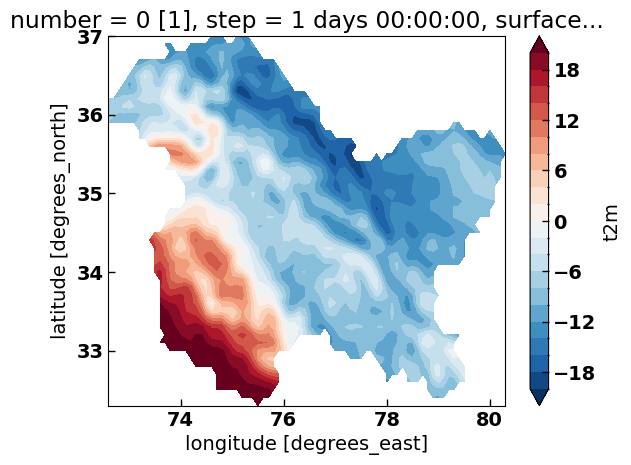
Analysis#
# Let's confirm if the shape of the dataset is same
print(ds_clipped['t2m'][0].shape) # [0] is for the first timestamp, 48 lats, & 78 lons, Temp. data
print(xds_cs.shape) # DEM data
(48, 78)
(48, 78)
xds_cs = xds_cs.rename({'y':'latitude',
'x':'longitude'}
)
xds_cs = xds_cs.drop_vars(['spatial_ref', 'band'])
xds_cs
<xarray.DataArray (latitude: 48, longitude: 78)> Size: 30kB
array([[nan, nan, nan, ..., nan, nan, nan],
[nan, nan, nan, ..., nan, nan, nan],
[nan, nan, nan, ..., nan, nan, nan],
...,
[nan, nan, nan, ..., nan, nan, nan],
[nan, nan, nan, ..., nan, nan, nan],
[nan, nan, nan, ..., nan, nan, nan]])
Coordinates:
* longitude (longitude) float64 624B 72.56 72.66 72.76 ... 80.06 80.16 80.26
* latitude (latitude) float64 384B 37.05 36.95 36.85 ... 32.55 32.45 32.35
Attributes:
AREA_OR_POINT: Point
units: m
scale_factor: 1.0
add_offset: 0.0
_FillValue: -32768.0ds_clipped = ds_clipped.drop_vars(['number',
'step',
'surface',
'spatial_ref',
'valid_time'])
temp = (ds_clipped['t2m']-273.15).mean('time')
print(temp)
<xarray.DataArray 't2m' (latitude: 48, longitude: 78)> Size: 15kB
array([[nan, nan, nan, ..., nan, nan, nan],
[nan, nan, nan, ..., nan, nan, nan],
[nan, nan, nan, ..., nan, nan, nan],
...,
[nan, nan, nan, ..., nan, nan, nan],
[nan, nan, nan, ..., nan, nan, nan],
[nan, nan, nan, ..., nan, nan, nan]], dtype=float32)
Coordinates:
* latitude (latitude) float64 384B 37.0 36.9 36.8 36.7 ... 32.5 32.4 32.3
* longitude (longitude) float64 624B 72.6 72.7 72.8 72.9 ... 80.1 80.2 80.3
print(xds_cs)
<xarray.DataArray (latitude: 48, longitude: 78)> Size: 30kB
array([[nan, nan, nan, ..., nan, nan, nan],
[nan, nan, nan, ..., nan, nan, nan],
[nan, nan, nan, ..., nan, nan, nan],
...,
[nan, nan, nan, ..., nan, nan, nan],
[nan, nan, nan, ..., nan, nan, nan],
[nan, nan, nan, ..., nan, nan, nan]])
Coordinates:
* longitude (longitude) float64 624B 72.56 72.66 72.76 ... 80.06 80.16 80.26
* latitude (latitude) float64 384B 37.05 36.95 36.85 ... 32.55 32.45 32.35
Attributes:
AREA_OR_POINT: Point
units: m
scale_factor: 1.0
add_offset: 0.0
_FillValue: -32768.0
Define the New Common Grid#
# Define the new common grid
new_latitudes = np.arange(start=min(temp.latitude.min(), xds_cs.latitude.min()),
stop=max(temp.latitude.max(), xds_cs.latitude.max()),
step=0.1) # Example step, adjust as needed
new_longitudes = np.arange(start=min(temp.longitude.min(), xds_cs.longitude.min()),
stop=max(temp.longitude.max(), xds_cs.longitude.max()),
step=0.1) # Example step, adjust as needed
Interpolate Both Datasets to the New Grid#
# Interpolate temp to the new grid
temp_interpolated = temp.interp(latitude=new_latitudes, longitude=new_longitudes, method='linear')
# Interpolate xds_cs to the new grid
xds_cs_interpolated = xds_cs.interp(latitude=new_latitudes, longitude=new_longitudes, method='linear')
Apply the Mask and Plot#
After interpolating both datasets to the same grid, you can then apply the mask (where xds_cs_interpolated is greater than 3000 meters) to the temp_interpolated dataset and plot the result.
# Create the mask based on the interpolated xds_cs
mask = xds_cs_interpolated > 3000
# Apply the mask to the interpolated temp DataArray
temp_masked = temp_interpolated.where(mask)
temp_masked.plot()
plt.title('Temperature for Areas Above 3000m (Interpolated)')
plt.show()
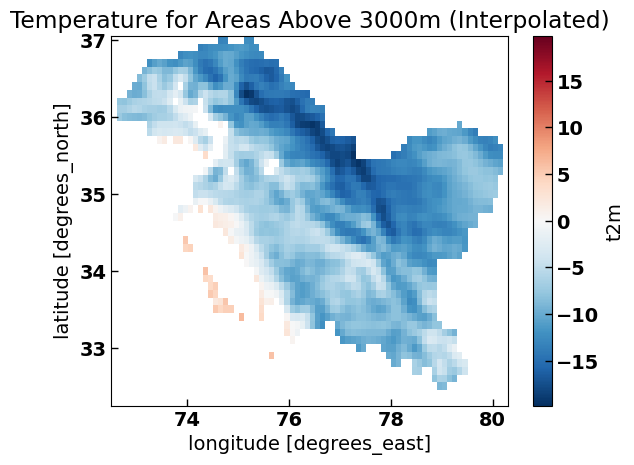
Plot Comparison#
fig = plt.figure(figsize=[16, 7], constrained_layout=True)
ax = plt.subplot(121, projection=ccrs.PlateCarree())
img = temp.plot.contourf(cmap='turbo', ax=ax, add_colorbar=False, levels=np.arange(-20, 20.1, 2))
mf.map_features(ax, b=True, l=True, states=False)
ax.set_title("Temperature")
combined_jkl.plot(ax=ax, ec='k', fc='none')
ax.set_aspect('equal')
ax = plt.subplot(122, projection=ccrs.PlateCarree())
temp_masked.plot.contourf(cmap='turbo', ax=ax, add_colorbar=False, levels=np.arange(-20, 20.1, 2))
combined_jkl.plot(ax=ax, ec='k', fc='none')
mf.map_features(ax, b=1, l=0, states=False,)
ax.set_title("Temperature for areas above 3000 m")
ax.set_aspect('equal')
cbar_ax = fig.add_axes([1, 0.25, 0.02, 0.5],) #lbwh
cbar1 = fig.colorbar(img, cax=cbar_ax,orientation='vertical')
cbar1.set_label(r'Temperature [$^\degree$C]')

Make Logo#
Let’s create logo for Jupyter Book to publish it to web
fig = plt.figure(figsize=[8, 7], constrained_layout=True)
ax = plt.subplot(121, projection=ccrs.PlateCarree())
img = xds_above_zero.plot.imshow(cmap='turbo', vmin=0, vmax=5000, ax=ax, add_colorbar=False)
# mf.map_features(ax, b=True, l=True, states=False, grids=False)
ax.set_title("")
combined_jkl.plot(ax=ax, ec='k', fc='none')
ax.axis('off')
# plt.savefig("logo.png", dpi=60, bbox_inches='tight')
plt.show()
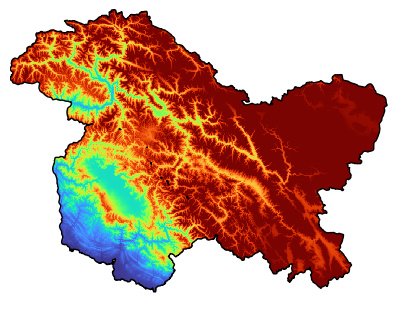
Thank you for your attention. Feel free to reach out in case you have any doubts.
